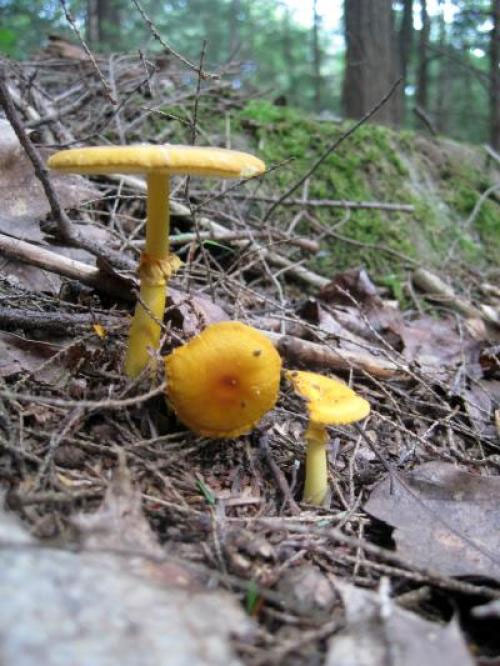New discovery of the role of fungi symbiotic roots with carbon in the atmosphere
(Recent research) Scientists say that symbiotic fungi living in plant roots have a big impact on atmospheric carbon.
The fungi that live in tree roots play an important role in the process of storing and releasing carbon from the soil when it is released, according to a researcher at the University of Texas at Austin, colleagues at Boston University and the Institute. Smithsonian Tropical Research Institute study said. The role of these fungi has not been evaluated and evaluated in global climate models.
Some parasitic fungi can lead to 70% more carbon stored in the soil.
'Natural carbon exchanges between soil and atmosphere are very large and play a special role in regulating the concentration of carbon dioxide in the atmosphere, and then on the Earth's climate , ' Colin Averill, co-author The main author of the study and a graduate student at the College of Natural Sciences at the University of Texas Austin said. 'This analysis clearly establishes that different symbiotic fungi reside in plant roots that affect large control of the global carbon cycle , which has not been fully appreciated or documented. proving to this day '.
'This study involves not only models and predictions of greenhouse gas concentrations in the atmosphere, but also challenges the core foundations in modern geological biochemistry, in which climate plays a role. Main control for soil carbon pools , 'said Adrien Finzi, co-researcher and biology professor at Boston University.

Averill, Finzi and Benjamin Turner, a scientist at the Smithsonian Tropical Research Institute, presented their study this week in the journal Nature.
The soil contains more carbon than the atmosphere and plants combined, so the forecast of future climate depends on an understanding of the carbon cycles between soil and air .
Plants convert carbon from the atmosphere during photosynthesis into carbon dioxide. Finally, when trees die, deciduous, or broken branches . all add carbon to the soil. Carbon remains in the soil until the ruins of the plant are decomposed by soil microorganisms that eat plant matter and other organic debris. This releases carbon back into the atmosphere.
One of the limitations is that both plants and soil microorganisms share the same nitrogen, an essential nutrient for all life forms. Most plants have a symbiotic relationship with mycorrhizal fungi (mycorrhizal fungi) , which helps them absorb nitrogen and nutrients from the soil and make this nitrogen usable for plants. Current studies show that plants and symbiotic fungi in their roots compete with soil microorganisms for available nitrogen in the soil and that this competition reduces decomposition in the soil.
There are two main types of symbiotic fungi, ecto and ericoid mycorrhizal (EEM) and arbuscular mycorrhizal (AM ) fungi . EEM fungi produce nitrogen-degrading enzymes, which allows them to absorb more nitrogen from the soil than AM.
Researching data globally, Averill and his colleagues found that where plants are partners with EEM fungi, soils contain up to 70% more carbon per unit of mass compared to locations where AM partner.
EEM fungi allow plants to compete with microorganisms for the available nitrogen source, resulting in lower total decomposition and lower carbon release back to the atmosphere.
This study is showing that plants and parts are actually connected to these root fungi, and you cannot make accurate predictions about the future carbon cycle without thinking about these two fungal groups. How to interact. We need to think about these systems as a whole.
The researchers found that the difference in this carbon storage is independent and has a greater impact than other factors, including total plant biomass, temperature and rainfall.
- Detecting carbon in soil being released into the atmosphere
- Ants can play the role of 'savior'
- Mushrooms and termites - Symbiotic relationship
- Adding lime to seawater: a way to reduce the rate of CO2 in the atmosphere
- Where is carbon stored on Earth?
- Discovery of carbon and life in the heart of the Earth
- Discovered where mushrooms have the greatest diversity in human skin
- Why is it only 0.04% of the atmosphere, but CO2 is still the main cause of global warming?
- Transform pine trees to increase carbon absorption
- NASA is about to announce a new discovery of the Martian atmosphere
- NASA is ready to launch satellites to measure CO2 on Earth's atmosphere
- Have you found a way to 'lock' faster carbon against climate change?
 Why do potatoes have eyes?
Why do potatoes have eyes? 'Tragedy' the world's largest carnivorous life: Death becomes ... public toilet
'Tragedy' the world's largest carnivorous life: Death becomes ... public toilet Tomatoes were once considered 'poisonous' for 200 years
Tomatoes were once considered 'poisonous' for 200 years Detecting microscopic parasites on human face
Detecting microscopic parasites on human face